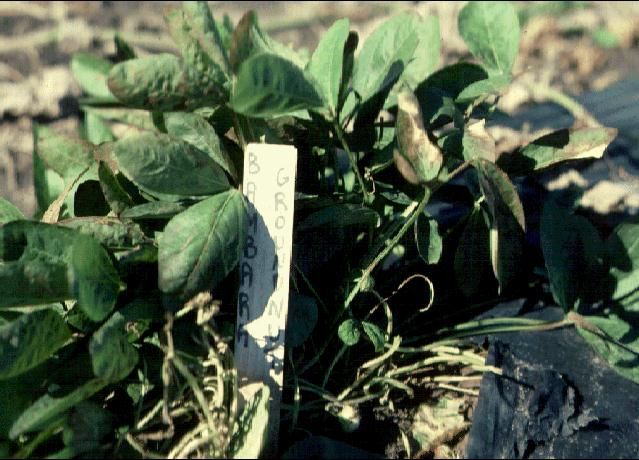Bambara Groundnut—Voandzeia subterranea (L.) Thouars1
Bambara (also spelled Bambarra) groundnut has many common names, such as Congo groundnut, Congo goober, Madagascar groundnut, earth pea, baffin pea, njugo bean (S. Africa), voandzou, nzama (Malawi), indhlubu, and underground bean.
Description
The leguminous plant is grown for its underground seeds. The entire plant is similar to the common peanut, being a low, flat annual with compound leaves of three leaflets. There is also an erect form. Like the peanut, it forms pods and seeds on or just below the ground. To achieve this, the flower stalk elongates and penetrates the soil. The bulbous tip creates a tunnel through which the fertilized flower, attached just behind the tip, is drawn into the soil.
The pods are round, wrinkled, and over ½ inch long. Each contains one or two seeds that are round, smooth, and very hard when dried. The seeds may be cream, brown, red, mottled, or black-eyed. There are numerous nitrogen-fixing nodules on the roots.
While seldom grown in the United States, Bambara groundnut, produces a nutritious food under cultivation throughout Africa. It was carried to America by slaves but has never become as popular as the peanut, which has a higher level of protein and is more robust in growth.

Credit: James M. Stephens
Apios (American Groundnut)
Do not confuse Bambara with Apios, also called Indian potato. This is a native perennial vine (resembling wisteria) that has edible seeds and tubers, which also can fix nitrogen in the soil.
Culture
Bambara groundnut grows best in climates suitable for peanuts. It needs bright sunshine, high temperatures, at least 4 months free of frost, and frequent rains to grow best. The plant, however, is highly adaptable and tolerates harsh conditions better than most crops. It yields under conditions too dry for peanuts, such as in the Bambara district near Timbuktu on the Sahara Desert's southern fringe. It also is known to grow in rain forest areas and the cool, moist highlands of Rhodesia.
Bambara groundnut is a natural for Florida gardens since it tolerates poor soils. In soils high in nitrogen, it produces mostly top and only a few pods and seeds. Fair plant growth and pod production were observed in fall trials in Gainesville, Florida.
Some of the pests attacking this plant are fusarium wilt, leaf spot, root-knot nematode, and a virus. These are more severe in rainy climates than in dry areas.
The crop has possibilities as a garden vegetable in Florida, but locating a seed source is one drawback as is the selection of a suitable cultivar.
When grown like the peanut, Bambara groundnuts take about 3–6 months to mature, depending on climatic conditions and the cultivar.
Use
The seeds may be eaten raw when immature, but become too hard when mature. When roasted or boiled, even the mature seeds are sweet and pleasant tasting. The seeds are often roasted and ground into a nutritious flour. Seeds contain 14-24% protein and about 60% carbohydrate. The protein is reported to be higher in the essential amino acid methionine than other grain legumes. Bambara groundnuts contain 6-12% oil, which is less than half the amount found in peanuts, making them not useful as an oilseed crop.


